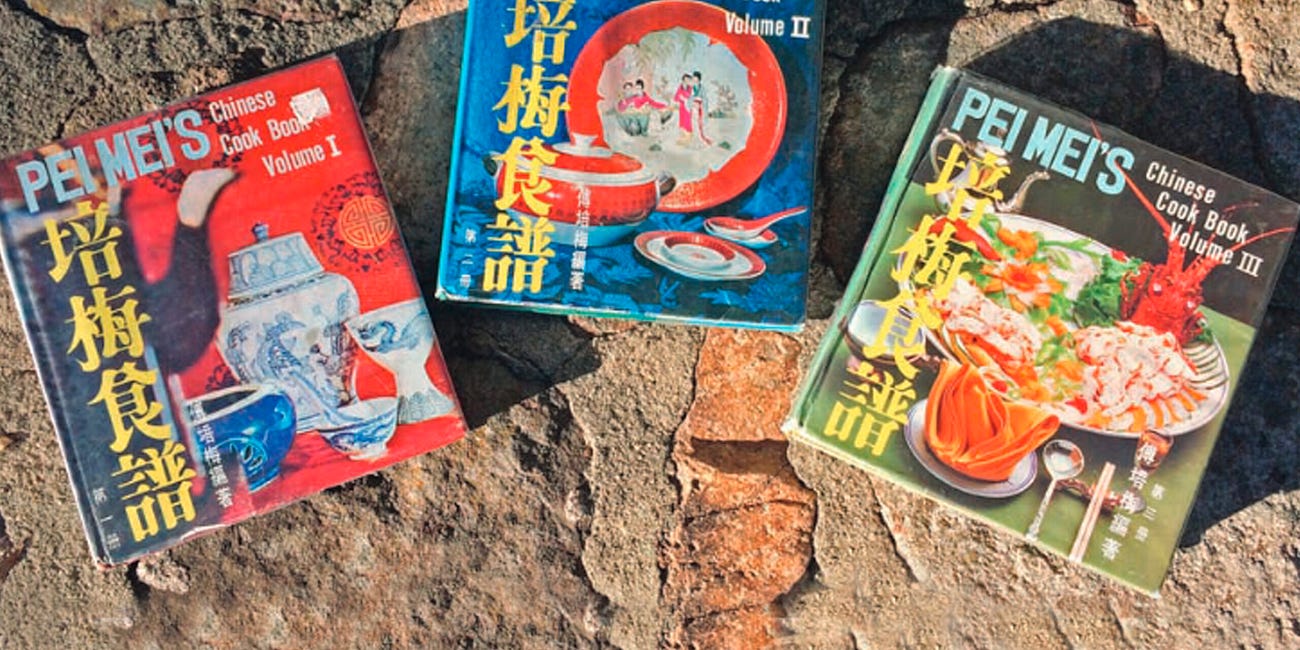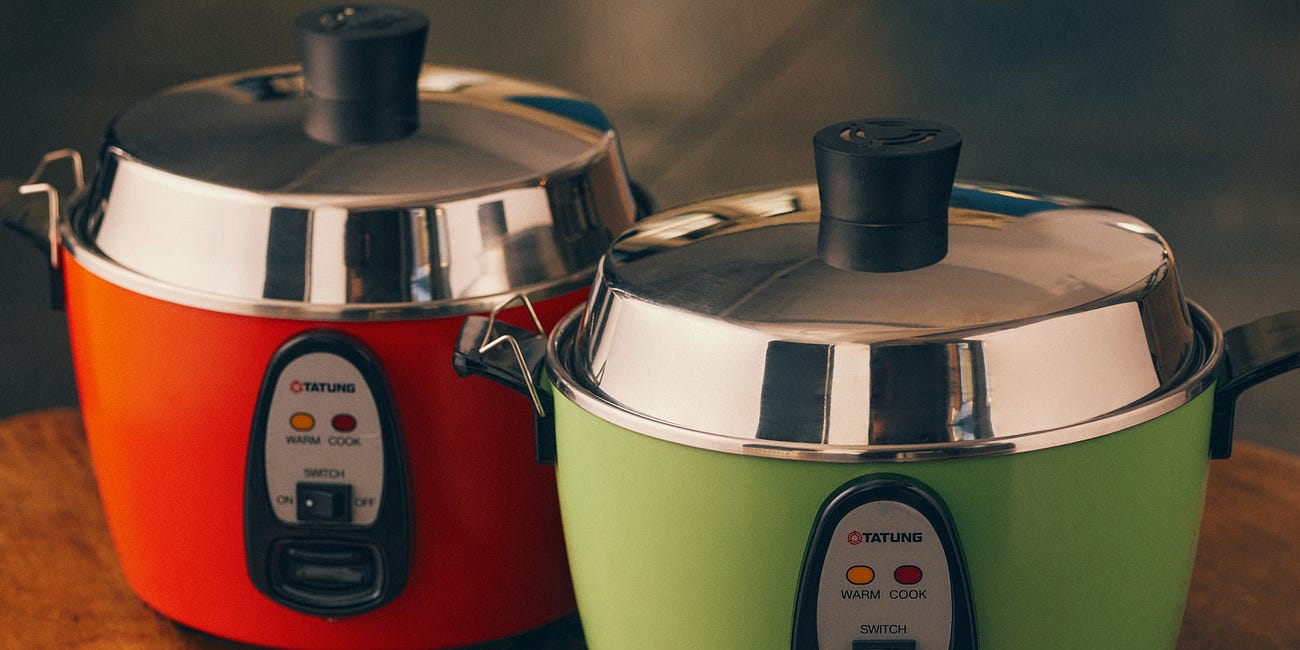Cooking with Steam Episode 02: Beef Noodle Soup
Taiwan's national dish made in Taiwan's national appliance
Cooking With Steam 好蒸氣 is a show about Taiwanese food. It’s part of Yun Hai Taiwan Stories, a newsletter about Taiwanese food and culture by Lisa Cheng Smith 鄭衍莉, founder of Yun Hai.
The second episode of Cooking with Steam is live!
When I polled readers of this newsletter on what you wanted me to make in the Tatung Rice Cooker and Electric Steamer, the number one request was… beef noodle soup. Interestingly, this is not rice-based, but fittingly, it is one of Taiwan’s most well known dishes.
I hadn’t actually made beef noodle soup in the Tatung before, but I thought it would be an interesting challenge that would showcase the steam cooker’s versatility. My mom told me that when she immigrated to the US, she didn’t need a stove because she had a Tatung in her dorm room. So, I developed a recipe to make the whole thing without turning on the stove at all, except for boiling the noodles. Watch to see how I did it.
Taiwanese beef noodle soup is perhaps the most well-known Taiwanese food outside of Taiwan. It’s actually a recently developed dish, emerging from communities of refugees who migrated from post-WWII China in the 1950s and on. People from diverse Chinese regions settled in close proximity to each other in military villages, and started mixing influences that previously were not core to Taiwanese foodways, like popularizing the use of wheat noodles and setting up the production of Sichuan-style chili bean paste. Beef was not a very affordable or common protein, but it became widely available because of US army surplus and aid. As a national dish, it’s a picture of some of the more recent forces that have impacted Taiwanese populations. Here’s a quick rundown on this history, courtesy Wikipedia.
I posit that there is no one ideal beef noodle soup, but many versions that are all correct. There are many ways to make the dish. Some methods involve 24-hour (or more) broths, others are fairly quick and no-fuss, made in a pressure cooker. In my kitchen, I usually start by red-braising beef shank, stewing it in a soy-based brine known as master stock or lu shui 滷水. This infuses the beef with seasoning and tenderizes it, too. Once that’s done, I separate the beef and strain the master stock. At this point, the beef can be refrigerated to be used in other dishes, like Hot and Numbing Beef Slices, and the stock can be frozen or refrigerated for future use.
Once I have these two elements—braised beef and stock—I can put together beef noodle soup on a dime. I dilute the master stock, which is very salty, with chicken broth or water. Then, I use this stock to warm slices of the braised beef. Spoon the whole thing over freshly cooked noodles and garnish with bok choy, Taiwanese sour vegetable (suan cai 酸菜), cilantro, scallion, and, my favorite, Su Five Spice Chili Crisp (which kicks up that red-braised, five-spice flavor even more).
For this episode, I developed a similar two-part process using only the Tatung Steam Cooker, employing a very unofficial hack to transform the Tatung into a dry heat source for sauté. I chose to enrich my stock with tomato (ok, ketchup) and onion, to give it that sweet edge so familiar in southern Taiwanese cuisine, but that’s optional.
This general concept of batch-then-assemble works great for almost any noodle soup. Braise or poach meats in enriched stock in a big batch, then use those elements, plus veggies and garnish on hand, to assemble a bowl of noodle soup any old night of the week.
And, if you don’t have a Tatung, no problem, just do this exact same thing on the stove.
Here’s the video:
COOKING WITH STEAM Episode 02
Beef Noodle Soup
好蒸氣 02 | 紅燒牛肉麵
Tips and Tricks
Here are a few things I go over in the episode that might be helpful.
Two Step Process
Step 1: First, braise the beef in a master stock. You’ll end up with tender pieces of beef and a richly flavored master soup base. This can be made ahead.
Step 2: Enrich the master soup base with tomato and onion to bring it closer to the sweet profile of a typical Taiwanese beef noodle soup. Dilute it with water or chicken stock, then reheat the beef slices in the soup. Combine with noodles, vegetable and garnish, served individually.
Sauté Hack
I demonstrate a very unofficial Tatung trick whereby you can tape down the switch to coax the Tatung to heat up even without water in it. This will create a dry heat source which you can use to bloom or sauté dry ingredients.
It’s a well-known folk hack, but because we also sell these, I have to caveat by saying we don’t know what effects this may have on the lifetime of the machine. We just know that people make popcorn with it this way, too.
Key Ingredients
DOUBANJIANG
In this episode, we feature doubanjiang 豆瓣醬, or fermented chili bean paste.
This is key to making Taiwanese beef noodle soup taste like Taiwanese beef noodle soup. It can be a bit tricky to buy because it’s often mislabeled (my jar was labeled as hot sauce/hot pot base). Watch for a run down on how to tell if you’re getting the right thing.
We like to use Ming Teh brand, available in most Asian grocery stores. They are one of the original producers of chili bean paste in the Gangshan district of Kaohsiung, Taiwan.
FIVE SPICE
You can use a store-bought five spice braising pack, but if you want to make your own, I share a quick rundown of what I usually put in mine.
SOY SAUCE
I also feature two different kinds of Taiwanese soy sauce:
Vat Bottom Soy Sauce: a black soybean soy sauce from the bottom of the brewing receptacle known for being exceptionally rich, salty and flavorful. The bottom is where all the umami settles. This sauce adds a foundational complexity to the stock.
Firewood Soy Sauce: an all-purpose soy sauce, with wheat, that has a lighter, zingier profile. This adds a sweet-leaning bright note to the soup.
Featured Recipes
Red Braised Beef Shank
serves 4
This is part one of the recipe—make this red braised beef shank and master stock first. Separate the beef and strain the stock. The beef can be store chilled in the fridge for several days and the stock can be frozen for several months.
Ingredients
440 g beef heel muscle (may also be called beef shin or shank)
4 pieces scallion, roughly chopped
4 slices ginger
1 head garlic, halved
3 pieces dried chili pepper
1 five spice braising pack, store-bought or homemade (see recipe below)
2 tbsp doubanjiang (chili bean paste)
2 tbsp Peanut Oil
26 g rock sugar
1/2 cup Taiwanese rice wine
2 tbsp Vat Bottom Soy Sauce (or high-salinity, heavy soy sauce)
1 tbsp Firewood Soy Sauce (or light soy sauce)
Salt, to taste
6 cups water
equipment
Kitchen tape
Tatung Electric Steamer (6- or 11-cup size; I use the 11-cup for this recipe)
Instructions
First, blanch the beef. Place the beef into the inner pot of the Tatung, then cover with water. The beef should be totally submerged.
Add 1 rice cup of water (~180 ml) into the outer pot of the Tatung.
Let steam for 15 minutes. Once the switch pops, open the lid. Remove the blanched beef using tongs or chopsticks, rinse the beef, then set aside. Clean out the inner pot.
Hack the Tatung in preparation for sautéing, or blooming, the aromatics by taping down the switch using kitchen tape. (This is an unofficial hack. Do not forget to remove the tape later!)
This step can also be done in a pan over the stovetop. If doing it over the stovetop, follow steps 5-8 to sauté the aromatics. Once done, transfer them into the inner pot.
Add peanut oil into the inner pot.
Add ginger, scallion, chili peppers, rock sugar. Sauté until fragrant.
Add the bean paste. Sauté until fragrant.
Deglaze the pot with the rice wine.
Remove the tape from the Tatung. Add the beef, two soy sauces, five spice braise pack, halved garlic head, and water, to cover the beef, into the inner pot.
Add 1 rice cup of water (~180 ml) into the outer pot.
Let steam for 15 minutes. Once the switch pops, open the lid and taste test the brine. It should taste too salty to drink, with a hint of sweetness. If it is not salty enough, add salt.
Add another 2 rice cups (~360 ml) into the outer pot and continue to braise.
Let steam for roughly 40 minutes. Once the switch pops, open the lid and test the beef to see if a chopstick can poke through. If not, cook longer. If so, let the beef cool down by itself for up to 2 hours. Refrigerate in the brine overnight for best results, like tea eggs. Or, if you want to get to the beef noodle soup right away, use directly.
Five Spice Braise Pack
makes 2 packs
Making your own five spice braising pack is easy and a nice way to customize your recipe. The non-negotiable five spices are star anise, cassia bark, fennel seeds, Sichuan peppercorn, and cloves. In this recipe, I’ve additionally included black peppercorn and bay leaves, but sometimes I also like to add sand ginger. I flub this in the episode, because for some reason it’s hard to remember five or more things under pressure. Make a few up at once so you always have one on hand.
Ingredients
6 pieces star anise
2 sticks cassia bark
4 tsp fennel seeds
2 tbsp Sichuan peppercorn
2 tsp cloves
2 tsp black peppercorn
2 bay leaves, optional
Instructions
Toast all the spices until aromatics (optional).
Divide them equally between two muslin bags, disposable pouches, or coffee filters, and tie up to seal.
Red Braised Beef Noodle Soup
serves 4
Here are simple instructions for transforming the red braised beef and stock into a Taiwanese-style beef noodle soup with sweetness from the onion and tomato (ketchup).
Ingredients
1 recipe red braised beef shank
440 g red braised beef shank
4 cups red braised beef master stock
1 white onion, sliced
1 tbsp Peanut Oil
2 tbsp ketchup (or tomato paste)
2 cups chicken stock (or water)
8 baby bok choy
4 servings guan miao noodles (I use the knife-cut variety, which we sell in our Brooklyn gamadiam)
for the garnish
1 cup Hakka Sour Mustard Relish (recipe below)
Scallion, sliced into small rings
1 bunch cilantro
equipment
Kitchen tape
Mesh strainer
Tatung Electric Steamer (6- or 11-cup size; I use the 6-cup for this recipe)
Instructions
Remove the beef from the brine and set aside.
Strain the brine using a mesh strainer or sieve. Press down on the aromatics in the strainer to extract as much flavor as possible. Discard the aromatics once done. The remaining liquid is your lu wei beef master stock. Set aside.
Optionally, if you like, you can skim the fat off the master stock (keep the fat as a condiment).
Slice the lu wei beef shank into 1/4” slices.
Hack the Tatung in preparation for sautéing the aromatics by taping down the switch using kitchen tape. (Do not forget to remove the tape later!)
This step can also be done in a pan over the stovetop. If doing it over the stovetop, follow steps 5-6 to sauté the aromatics. Once done, transfer them into the inner pot.
Add peanut oil into the inner pot.
Add onion and ketchup. Sauté for several minutes, until onion is cooked down.
Add the lu wei beef master stock, chicken stock (or water), and the sliced lu wei beef shank.
Add 1 rice cup of water (~180 ml) into the outer pot. Let steam for roughly 15 minutes.
While the soup is steaming, cook your bok choy and guan miao noodles.
Boil water in a pot over the stovetop. Once the water has reached a rolling boil, blanch the bok choy, then remove from the water and set aside.
Add guan miao noodles into the same pot, and cook until JUST al dente. Strain the noodles from the pot and set aside.
Assemble the beef noodle soup. For each bowl:
Place one serving of guan miao noodles in a bowl.
Strain beef soup into the bowl.
Lay sliced beef on top.
Lay a few pieces of bok choy down.
Add a few heaping spoons of Hakka sour mustard relish.
Top with cilantro and scallion.
Serve with Su Chili Crisp, Five Spice.
Hakka Sour Mustard Relish
serves 4
To me, you can’t have Taiwanese beef noodle soup without this sour vegetable, but it truly is optional. Pick up a pack of sour mustard (suan cai) at an Asian grocery store, and follow the recipe to cook it into a relish. A big batch will keep in the fridge for a couple weeks.
Ingredients
3 cups suan cai, chopped into small pieces (smaller than bite size, but not a mince)
6 cloves garlic, minced
4 dried chili peppers
Sugar, to taste
2 tbsp Peanut Oil
White Sesame Oil, to taste
White pepper, to taste
Instructions
In a hot wok, add peanut oil and stir fry the dried chili pepper and garlic until fragrant.
Add in suan cai. Stir fry to cook, then add white pepper and sugar.
Remove from heat and stir in sesame oil.
Refrigerate for up to a couple weeks.
About the Tatung
If you’re new to the Tatung, be sure to check out the intro episode, which will provide a quick tour:
And if you haven’t seen it yet, check out the first episode, where I make a simple breakfast featuring Steamed Eggs:
Ingredients and Equipment
For the recipes, I use the 11-cup Tatung Steamer to make the red braised beef shank, and the 6-cup Tatung Steamer for the beef noodle soup. To chop, I’m using our Maestro Wu Vegetable Cleaver on a round ironwood cutting board.
I’m also demonstrating how to use a few Yun Hai products, like peanut oil, Vat Bottom Soy Sauce, Firewood Soy Sauce, and salt.
The blue and white curtain in the background is by Hsien Hua Li, who made a similar curtain for our store. The white bowl was made by my friend Matthew So.
Gratitude and Acknowledgements
We couldn’t have done this without the support and passion of our friends and community. So much love and gratitude to Night Shift, who produced this, and all our creative collaborators for giving the show its unique voice.
Credits
Produced by Night Shift and Yun Hai
Made possible by Tatung Taiwan
Team:
Lisa Cheng Smith, host
Amalissa Uytingco, culinary producer
Sam Broscoe, producer
Alec Sutherland, director & editor
Nathan Bailey, director of photography
Bryan Bonilla, camera operator
Naomi Munro, production designer
Alexandra Egan, art director
Kyle Garvey, sound mixer
Rebecca Alexander, hair and makeup
Dustin Wong, music
O.OO, graphics
Jil Tai & Ben Hill, motion design and title sequence
R. Hollis Smith, mix
Our Set
Our set features props from Taiwanese, Taiwanese-American, and American friends worldwide, creating those Taiwancore vibes we love so much at Yun Hai.
Thank you for the beauty Mikey Chen, Lillian Li, Emilie Liu, Debbie Carlos, Matthew So, Kelli Cain, Material Kitchen, Mogutable, Felicia Liang, Sam Tilney, Lulu Yao Gioiello, Grace Jung, Eric Sze, Julianne Ahn, James Smith, CS Agnes Cheng, and Leh Lin.
Special Thanks
Russell Wang, Maggie Chang, Shirley Liu, Ivan Wu, Feng Hsieh, Hollow, Chris, Leon, Simon, Lillian Lin, Jasmine Huang, Natya Regensburger, Cat Yeh & the entire Yun Hai Team, our partners, and our wonderful community.
I’ll be back with the next episode in March.
Your resident steampunk,
Lisa Cheng Smith 鄭衍莉
Written with research and editorial support by Amalissa Uytingco, Jasmine Huang, and Lillian Lin. If you enjoyed this newsletter, please share it with friends and subscribe if you haven’t already. I email once a month, sometimes more, sometimes less. For more Taiwanese food, head to yunhai.shop, follow us on instagram and twitter, or view the newsletter archives.
From the Archives
A short selection of recent and not-so recent posts from this newsletter
好蒸氣: Cooking with Steam
This is Yun Hai Taiwan Stories, a newsletter about Taiwanese food and culture by Lisa Cheng Smith 鄭衍莉, founder of Yun Hai. If you aren’t yet a subscriber, sign up here.
大同電鍋: Taiwan and its Steam Cooker
This is Yun Hai Taiwan Stories, a newsletter about Taiwanese food and culture by Lisa Cheng Smith 鄭衍莉, founder of Yun Hai. If you aren’t yet a subscriber, sign up here.
水果箱 : The Art of the Taiwanese Fruit Carton
This is Yun Hai Taiwan Stories, a newsletter about Taiwanese food culture by Lisa Cheng Smith 鄭衍莉, founder of Yun Hai Taiwanese Pantry. If you aren’t yet a subscriber, sign up here.








I love how you adapted this for the Tatung and it's so funny how you describe that many of the ingredients can be flexible. Can't wait to try it!